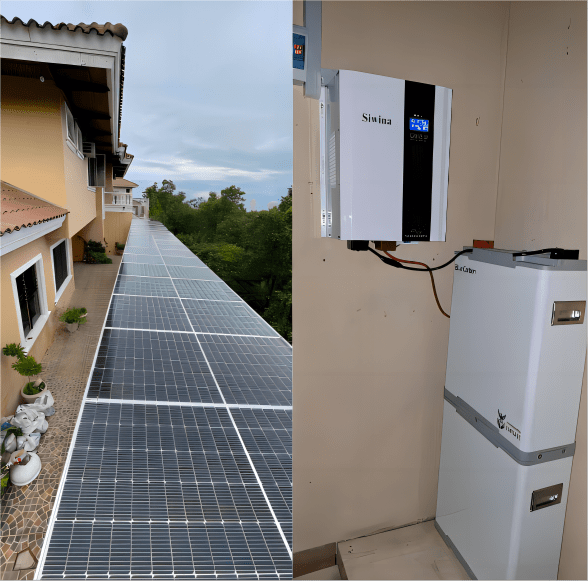When designing and installing a solar energy system, selecting the right equipment is crucial to ensure optimal performance. Two common configuration options are all-in-one inverters with built-in solar controllers and separate inverters + controllers. This article will provide a detailed analysis of the advantages and disadvantages of both options, helping distributors, installers, and end-users make informed decisions.
1. What is an All-in-One Inverter with a Built-In Solar Controller?
An all-in-one inverter is an integrated device that combines the functions of an inverter and a solar controller. It directly converts the direct current (DC) generated by solar panels into alternating current (AC) while managing the charging and discharging of batteries.

Advantages:
Space-saving: Compact design, ideal for installations with limited space.
Easy Installation: Fewer connection cables reduce installation complexity.
Cost-Effective: Typically more economical than purchasing an inverter and controller separately.
Strong Compatibility: Designed specifically for solar systems, ensuring seamless coordination between the inverter and controller.
Easy Maintenance: A single device means fewer failure points and simpler maintenance.
Disadvantages:
Lower Flexibility: If one component (e.g., inverter or controller) fails, the entire device may need replacement.
Power Limitations: The power range of all-in-one inverters may be limited, making them unsuitable for large or complex solar systems.
Difficult to Upgrade: Future upgrades to the inverter or controller may require replacing the entire device.
2. What is a Separate Inverter + Controller?
A separate inverter + controller configuration uses an inverter and a solar controller as two independent devices. The inverter converts DC to AC, while the controller manages battery charging and discharging.

Advantages:
High Flexibility: Allows selection of different brands and models of inverters and controllers based on system requirements.
Scalability: Suitable for large or expandable solar systems.
Fault Isolation: If one device fails, only that device needs replacement, without affecting the other.
Optimized Performance: Independent devices often offer higher power ranges and more advanced features.
Disadvantages:
Complex Installation: Requires more connection cables and installation steps, increasing complexity.
Larger Space Requirement: Two separate devices require more installation space.
Higher Cost: Purchasing an inverter and controller separately may be more expensive.
Compatibility Issues: Ensuring compatibility between the inverter and controller is necessary to avoid performance issues.
3. How to Choose the Right Configuration?
When to Choose an All-in-One Inverter:
Small to medium-sized solar systems (e.g., residential or small commercial use).
Limited installation space.
Budget constraints, aiming to reduce initial investment.
Need for quick installation and simplified maintenance.

swn inverter project case min 2.png
When to Choose a Separate Inverter + Controller:
Large or complex solar systems (e.g., industrial or large commercial use).
High flexibility and scalability requirements.
Demands for superior system performance.
Plans for future system upgrades or expansion

swina inverter case min1 min11.png
Final Considerations and Recommendations
1. As prospective buyers, distributors, and installers evaluate their options for solar system configurations, it is essential to consider several key factors that will ultimately lead to an informed decision. At the forefront of these considerations is the evaluation of individual energy needs and preferences. Understanding the specific requirements of the property in question, including energy consumption patterns and appliance usage, is critical in determining the capacity of the solar system required.
2. Another important aspect to assess is the available space for installation. An all-in-one inverter with a built-in solar controller may be advantageous for projects with limited space, as it simplifies the installation process by combining capabilities. Conversely, separate inverter controllers may offer greater customization, allowing users to tailor systems according to specific requirements and future expansion plans. Potential buyers should meticulously consider their immediate needs alongside their long-term expectations regarding scalability.
3. Budget constraints are also a principal concern when deciding between configurations. While all-in-one solutions can present cost savings through streamlined components, separate systems might offer flexibility better suited for particular financial plans and goals. It is essential to weigh the initial investment against potential long-term savings from energy production and maintenance over time.
4. Lastly, consulting with solar energy professionals is highly recommended. Experts can provide insight into the most suitable configurations, considering local regulations, incentives, and technological advancements within the solar sector. Engaging with professionals ensures that potential buyers select a system that not only meets their energy goals but also adheres to best practices in installation and maintenance. By taking these factors into account, individuals and businesses can enhance their solar energy experience and fully realize the benefits of renewable energy.
Conclusion
Whether you choose an all-in-one inverter with a built-in solar controller or a separate inverter + controller, the decision should be based on your specific system requirements, budget, and installation environment. All-in-one inverters are ideal for small systems and simplified installations, while separate devices are better suited for large systems and future expansions. We hope this article helps distributors, installers, and end-users make informed decisions to build efficient and reliable solar systems. Link to “How to Install a Solar System”https://swninverter.com/how-to-install-a-solar-power-system-a-step-by-step-guide-for-homeowners-and-installers/
If you have further questions about solar system configurations, feel free to contact our expert team for personalized solutions!



